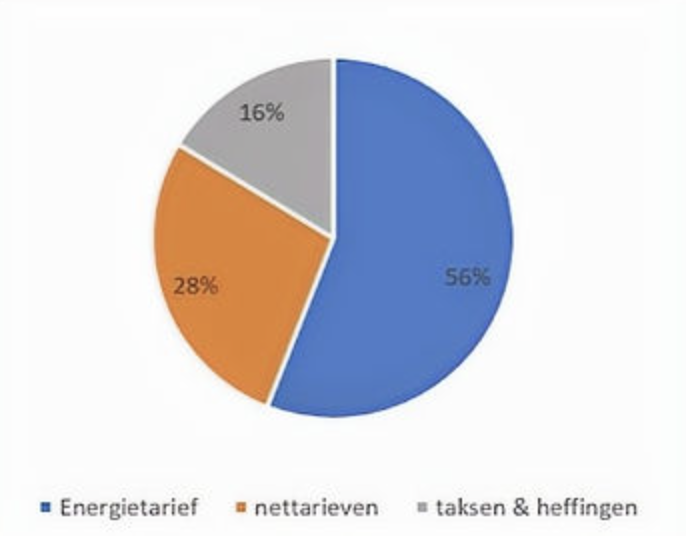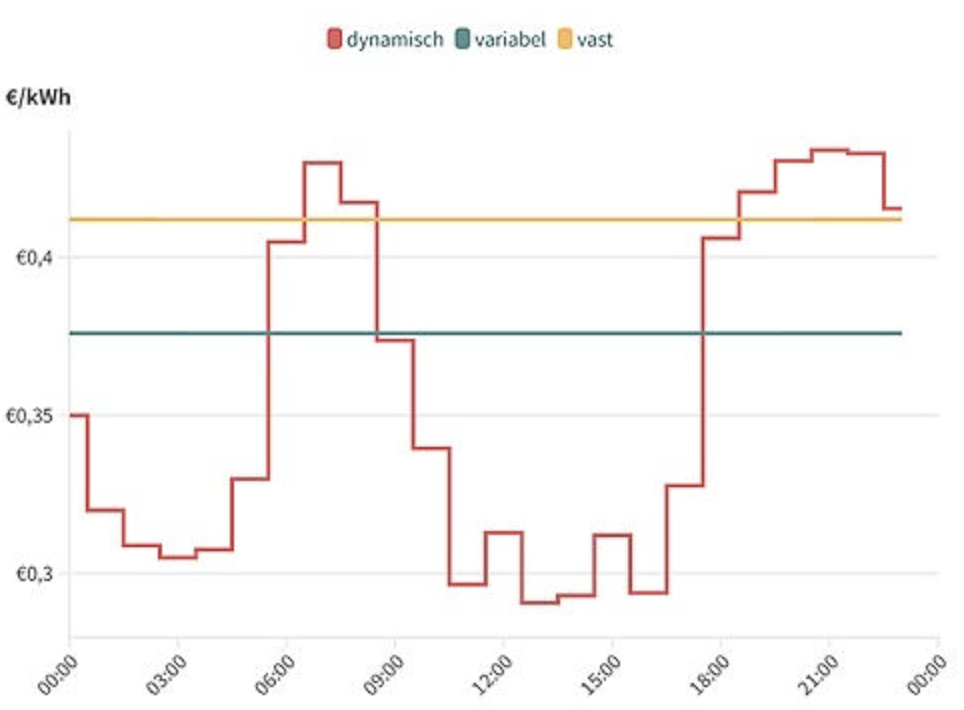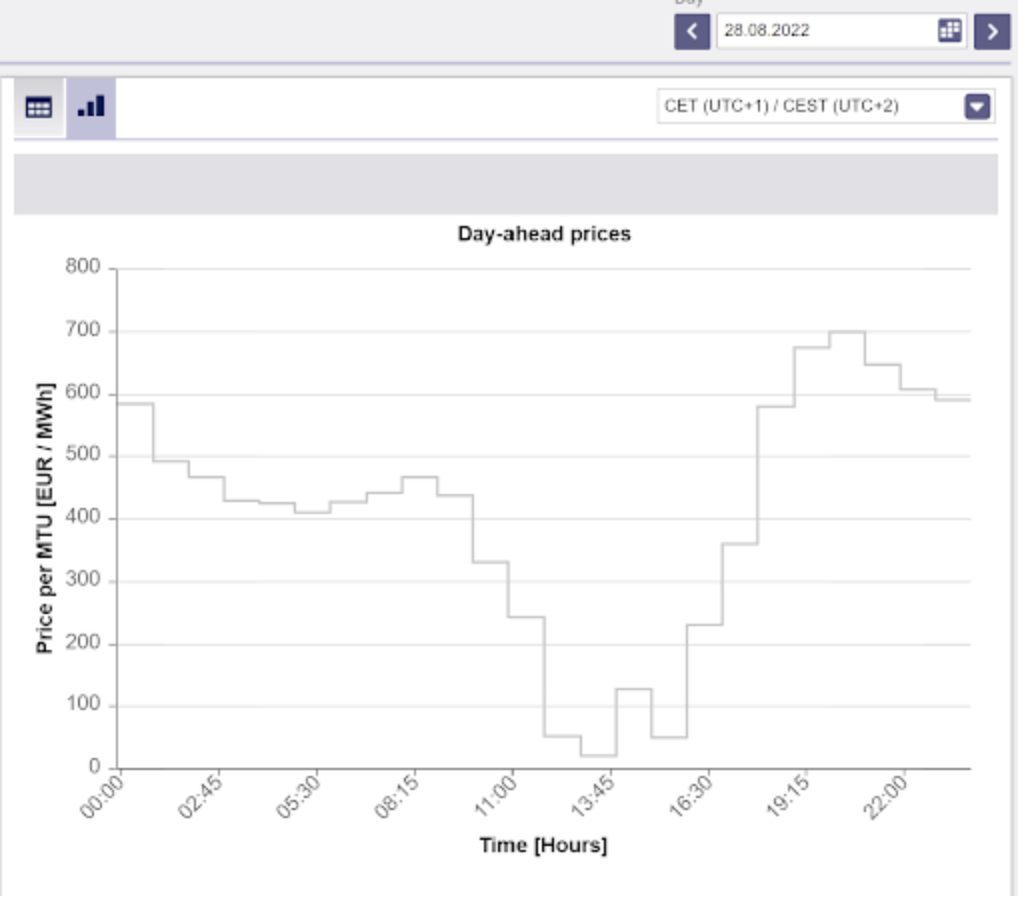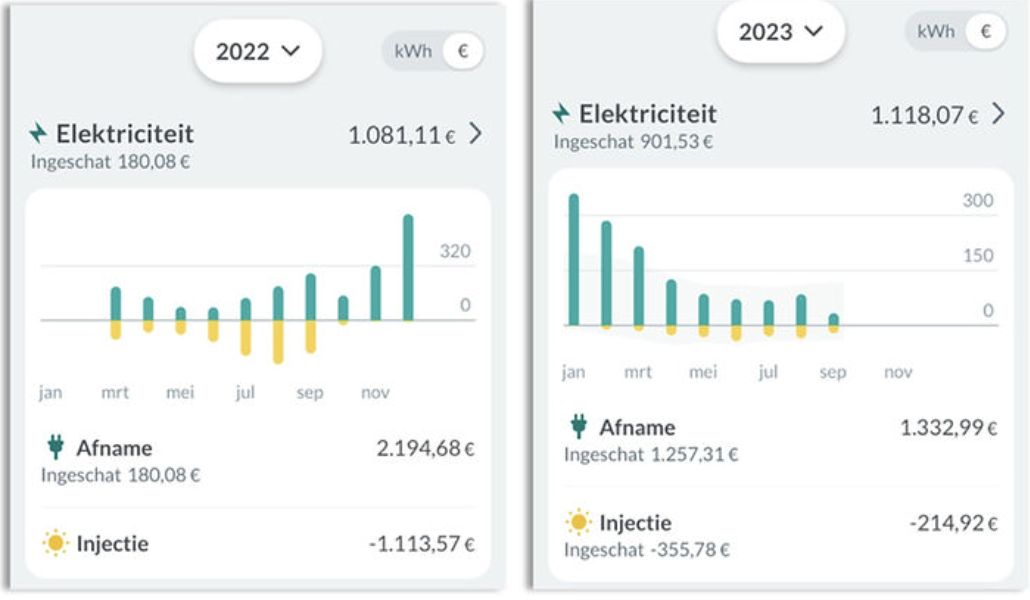Are you losing track of the different energy tariffs? Discover in our blog how to choose the best energy tariff for FlexiO and maximise your savings. Learn about fixed, variable and dynamic tariffs and how FlexiO can help you make the most of your energy installation.
Are you overwhelmed by all the different energy tariffs and why this is important for FlexiO? Find out in this blog and choose the energy tariff that suits you best.
The structure of your energy bill
Your energy bill consists of three parts:
- Energy costs
- Grid tariffs
- Taxes and levies
Grid tariffs, taxes and levies are set by law. You have no choice in this matter. Your energy costs are strongly influenced by your energy tariff.
You choose this yourself. For an average family with an annual consumption of 3,500 kWh and a digital meter with a day and night regime, the energy cost accounts for approximately 56% of the total energy bill. This means that a large part of your energy bill is determined by your choice of energy tariff.

The basic principles of the energy market
It is important to first understand a number of basic principles. The market price of energy is determined by supply and demand, which must always be in balance.
In the past, energy was mainly produced by nuclear, gas and coal-fired power stations, whose production is highly predictable and stable. Each of these energy sources has its own production cost. Typically, this meant that the price of energy was low at night and higher during the day when demand was higher and more expensive gas-fired power stations had to be used.
Today, there is much more renewable energy in the system. Its production varies depending on the weather and the production cost is very low. When there is a lot of wind and sun, the price of energy will be low. Below you can see the value of electricity on the wholesale market for a random weekday in September in 2016, 2019 and 2023.

You can clearly see the impact of renewable energy on the wholesale price. When there is a lot of renewable energy, the price drops dramatically, and vice versa. Your energy supplier will purchase part of the energy it has to supply you in advance and another part based on these wholesale prices.
4 types of energy tariffs
A fixed energy tariff
A fixed tariff usually applies for a period of 1 or 3 years. This gives you certainty about the unit price you pay for your energy. If energy prices rise structurally, your supplier will have to purchase part of the energy at a higher price.
If energy prices fall, you as a consumer can cancel your energy contract. This leaves your supplier with a surplus of energy that they have to sell at lower prices. Your energy supplier therefore takes all the risk for what may happen on the energy market. They charge a risk premium for this, which is included in your fixed rate. This means you pay a higher fixed price per kWh.
However, a fixed rate does not say anything about how cheap or how expensive your energy is. If you had fixed a fixed rate just before the energy crisis in 2022, you would have done well. If you fixed a rate at the last minute when fixed rates were still being offered in the midst of the crisis, you would have done badly.
A variable energy tariff
A dynamic energy tariff
The graph below shows the different energy tariffs offered by your energy supplier. Can you see the link with the wholesale market (see graph above)?

When choosing your energy tariff, you naturally base your decision on price, but also on how much certainty you want.
A dynamic tariff combined with the smart control of FlexiO
If you opt for a dynamic energy tariff, you can adjust your consumption and injection to these different prices throughout the day: you use the electricity from your battery when prices are high and you may inject solar energy that you have produced earlier.
When prices are low, you store electricity from your solar installation in your battery and consume energy from the grid for your consumption.
As a FlexiO owner, you don't have to do this yourself, of course; FlexiO takes care of everything for you. This allows you to focus on what is important to you.
Did you know that an average FlexiO user with solar panels and a battery saved up to 25 EUR/month extra last year thanks to smart control in combination with a dynamic energy tariff compared to a user with a variable tariff? In the latter case, FlexiO can only respond to the capacity tariff, self-consumption and, to a limited extent, your energy tariff if you have a dual energy tariff.
A Flex Tariff
The Flex Tariff by LIFEPOWR takes the benefits of a FlexiObox a step further. The Flex Tariff is just like a standard dynamic energy tariff, where your energy price changes hourly according to day-ahead prices. Because LIFEPOWR eliminates the cost risk for the energy supplier, the Flex Tariff is cheaper than a standard dynamic tariff.
On top of this advantageous tariff, you also get access to real-time market prices, otherwise known as imbalance prices. This allows your installation to respond to this market in real time to gain extra benefits for you! We call this technology eBalancing.
Watch out! The Flex Tariff is not the same as ENGIE’s Empower Flextime. Empower Flextime is a variable contract but it’s not a contract with a dynamic rate, and is not compatible with LIFEPOWR’s Flex Tariff.
And what about the energy crisis year of 2022?
Indeed, prices for variable and dynamic contracts skyrocketed. But because there was a very large difference in hourly prices during the day, FlexiO was able to take full advantage of this.
How is this possible? Take 28/08/2022 as an example. We are in the midst of the energy crisis and below you can see the prices on the wholesale market:

On this day, FlexiO fully charged the battery during the afternoon using solar power at approximately 0.05 EUR/kWh. In the evening, not only was the home's consumption covered, but electricity from the battery could also be sold to the grid at approximately 0.7 EUR/kWh.
A 20 kWh battery generated 14 EUR in one evening. As a result, Wannes had the same final bill in 2022 as in 2023, thanks to smart control by FlexiO in combination with a dynamic energy tariff.

I want a Flex Tariff!
If you would like a Flex Tariff, please check the compatible energy suppliers here.
If you want a dynamic tariff we advise you to contact Trevion, ENGIE, Bolt, EBEM, Octa+, Ecopower, Frank Energie or Eneco. They are currently the providers of dynamic energy tariffs.
So now you are fully up to date with all the possible energy tariffs. If you still have any questions, please contact us. We will be happy to help you!








